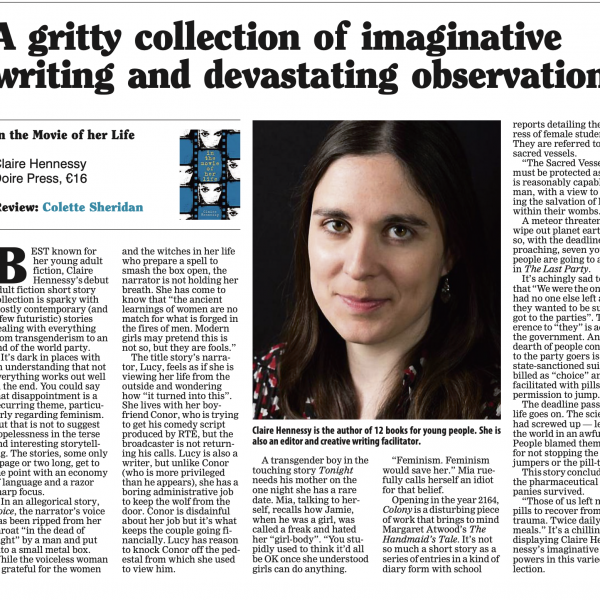Ian Kelly Writes in The Telegraph on the Enduring Legacy of Mr Foote

Heard the one about the comedian with one leg called Foote? What’s his other leg called? Heard the one about the depeditation of Mr Foote? Well – it’s half true.
Jokes tumble down the ages, their provenance often lost. But that first one originates with Samuel Foote (1720-1777), one-legged Georgian transvestite comedian, the second with his friend Dr Johnson. The play Mr Foote’s Other Leg, which opens in the West End next week starring Simon Russell Beale, is a story celebrating the lost voices of Georgian London but is also the tale of a pivotal figure in the linked histories of comedy, fame, sexuality and medicine.
It is the story of Sam Foote, the most famous man in Georgian England you’ve never heard of, but is also an exploration of the explosion of energy – philosophical, scientific, theatrical and comedic – that made 18th-century London so thrilling. But as I sit in the wings listening to it and writing this, I reflect that what now rocks a theatre with laughter and tears are Foote’s and his contemporaries’ heroic and very modern-feeling lives. The past, sometimes, is very much with us.
This week, Foote’s tale comes full circle, via a sell-out run at Hampstead Theatre, back to the Haymarket, a theatre Foote ran and which holds the title “Theatre Royal” entirely because of him. It is only as a result of royal contrition after a disastrous regal practical joke led to Foote’s (unanaesthetised) leg amputation that his theatre was granted the Theatre Royal status at all.
So next week marks something of a return to form for this lost hero of British culture, the Oscar Wilde of the 18th century and man once upon a time more famous than his friend David Garrick. And after two and half centuries of neglect, this is a appropriately a project championed by another hero of the British theatre, the legendary producer Michael Codron, now spearheading the return of Foote to his home, the Haymarket.
Indubitably, Foote would approve. It was Codron who brought to London such sexually frank plays as Joe Orton’s Entertaining Mr Sloane and Frank Marcus’s The Killing of Sister George, which lead in turn to Codron’s involvement in the so-called “dirty plays” controversy and the campaign, as he put it, “to liberalise things in theatre” as they had been in the literary world by the Chatterley trial. Like Codron, Foote was a fearless impresario, passionately committed to the importance of live arts in celebrating life and safeguarding freedom.
In the 18th century, they used letters to tell stories. They had epistolary novels, and plays with plots that hinged on opened envelopes. So although this play is now described by some as part of the site-specific theatre-of-the-moment that’s so in vogue, it is uniquely a theatre-about-theatre play in the very theatre where it is set. In fact, its genesis was rather old-fashioned and epistolary, a story of letters that has ended up as a love-letter to the theatre.
First of all there was the letter of November, 1763 from Giacomo Casanova, with a note about bumping into Sam Foote outside the Haymarket. It is now in the Prague Archive of Casanova’s ephemera. This is where the tale began for me, as I wrote a biography of Casanova and that’s where I first read of Foote, when I was trawling the archive in 2006.
Next letter, May 2008. I am completing the Casanova biography while appearing in Lee Hall’s The Pitmen Painters at the National Theatre. Lee writes to me as Pitmen re-opens at the Lyttleton, suggesting I look at the story of Sam Foote. I do – Lee is a genius. I begin research proper on the biography.
January 2013. My Foote book wins a Society of Theatre Research Award, and I receive a letter from Michael Codron, saying he has read it and asking to meet. I can’t say I hadn’t already thought of the Foote story as a play, but it didn’t occur to me that he would be so adamant that I was the man to write it.
So there it is. I hope Foote, man of letters and of the theatre as he was, is getting some satisfaction or even a smile out of all of this, from his lost grave near Poet’s Corner. He once said that there is no laughter in posterity, but maybe, at last, there is now.
So why now? Foote’s name was soon forgotten after his death in 1777, as comic’s names and talents so often are. But in Foote’s case there were particular reasons for his fall from grace and public favour: his career ended in a notorious sex-crime trial that meant his name became practically unmentionable; and the uni-ped author of hit comedies for one-legged actors has to take some ownership of his own obscurity.
But it was his fall and his desuetude that always intrigued me as much as his comedy. He is a walking – limping – metaphor for the evanescence of a performer’s art, and at the same time, post-leg-amputation, the embodiment of something we seem to still find fascinating: the pained or destroyed celebrity.
Originally from Truro, son of a Cornish lawyer who married well, Foote shot to fame just after being sent down from Oxford (he tied the Provost of Worcester’s cow to the college bell and set fire to its tail) and achieved further fame and notoriety even before his meteoric stage career as a result of the murder of his uncle, by his other uncle, about which Foote wrote. One uncle was garotted, the other hanged for the crime and their nephew’s account became a bestseller.
The biography, not the play, is a lot about the murder, for Foote holds his place in the history of British crime writing as well the history of celebrity. But he was also almost certainly homosexual, in an age that, arguably, was relatively liberal in its attitude to metropolitan sexual practice. Foote combined this with a conspicuous love of dressing up in women’s clothing – both on- and possibly off-stage. He was, as a performer, the Eddie Izzard of his day, but ended up at the centre of probably the modern world’s first media storm when, in the summer of 1776, he was arraigned for “sodomitical assault”.
Irrespective of what really happened between Foote and his footman (who became known as “Roger the Footman” in the London papers), Foote was the victim of turning tide of prejudice against London’s “gay” community. But his real crime may well have been simply to be too daringly satirical, and to have provided fodder for a “tabloid” fire-storm when, in retrospect, one might wonder why the London papers weren’t more interested in America’s Declaration of Independence.
Foote the celebrity was widely recorded, and celebrated portraitists begged him to sit for them. Foote the man was more elusive. He left many plays and recorded bons mots, but he was slippery, as comics often are. He appears to have been a lonely figure, with one possible long-term male partner and a failed early marriage.
Quite accidentally, when researching the amputation of Foote’s leg for the biography, I found out what may have lay behind Foote’s psychological issues and his demise. I came across records of Foote’s “nerves” made by the surgeon John Hunter, his friend and the Oliver Sacks of his day. Foote became clinically disinhibited, maybe even sexually so, in the closing years of his life.
This took me into whole new realms of research in terms of the dawning understanding of psychology in the late-18th century but also to one central concern of the play. In trying to understand the workings of the mind, at the birth of what would now be term “psychology”, Hunter used Foote as a case study and also used the most obvious metaphor for a Londoner of his era, the theatre itself, as a paradigm by which to understand the psyche.
Consciousness, as Descartes had argued before Hunter, is like a theatre: it takes an audience to construct meaning. It was in seeing those Hunter letters, in effect, that I knew I had more than a comedy: I had a play.
Foote’s legacy is various and not restricted to the history of comedy. He holds a key place in the birth of modern celebrity culture – as even Lord Byron later recognised – and in the story then and now of our fascination with the famous. Thanks to Hunter, who used him as a case study, he holds his place in the history of medicine and in the history of disability, appearing on stage, post-amputation, and triumphing over physical adversity.
But it is as a forgotten comic that Foote’s story is for me most emotive, and most telling in the theatre. Comics are forgotten. So are most actors – and indeed producers. Yet theatres often feel “ghosted” by the knowledge that great truths have been enunciated and great talents have worked on those stages.
Foote’s story is of that signal magic of the performance-arts, the dance around the fleeting nature of things. When we come together to hear a story played by actors, the laughter and hopes and fears of our lives are celebrated within the context of their passing.
Which I suspect is why, at the curtain-call, I see as many tear-stained faces as laughing ones, and why an audience once again cheers for Samuel Foote and in “his” theatre – as they did once before on the eve of the trial that would destroy him – a man who stood up, on one leg, against adversity and turned his life to laughter and to celebrating freedom, even into his last act.
http://www.telegraph.co.uk/theatre/what-to-see/mr-foote-the-one-legged-georgian-transvestite-who-enthrals-us-still/



